29 July 2007, Olinda
Written 29 July 2007
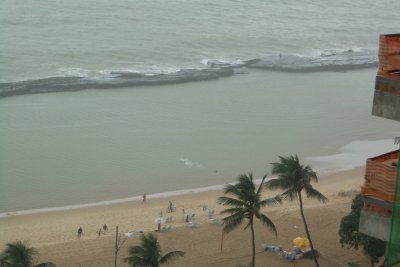 The rain has returned, but I can see a big patch of sun out over the sea, and it seems to be coming this way. The tide has receded sufficiently to reveal a line of flat black rocks, a few yards below the beach—part of the reef for which Recife is named.
The rain has returned, but I can see a big patch of sun out over the sea, and it seems to be coming this way. The tide has receded sufficiently to reveal a line of flat black rocks, a few yards below the beach—part of the reef for which Recife is named.
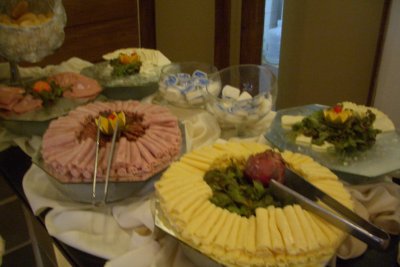 The hotel's buffet breakfast is included in the price of our room, and quite a nice one it is: several kinds of cut and whole fruit, three cheeses, ham, salami, mortadella, half a dozen kinds of little sweet and savory yeast breads, butter, jam, cereals, coffee, tea, hot chocolate, cakes, pastries, flans, and chafing dishes full of little spherical cheese breads (delicious!), hot sliced sausages sautéed with onions, scrambled eggs (of no great merit), crisp bacon, chunks of hot boiled yam, domes of polenta as big around as fried eggs in a sauce of what seems to be warm milk, and finely shredded "jerked beef" sautéed with onions and chilis.
The hotel's buffet breakfast is included in the price of our room, and quite a nice one it is: several kinds of cut and whole fruit, three cheeses, ham, salami, mortadella, half a dozen kinds of little sweet and savory yeast breads, butter, jam, cereals, coffee, tea, hot chocolate, cakes, pastries, flans, and chafing dishes full of little spherical cheese breads (delicious!), hot sliced sausages sautéed with onions, scrambled eggs (of no great merit), crisp bacon, chunks of hot boiled yam, domes of polenta as big around as fried eggs in a sauce of what seems to be warm milk, and finely shredded "jerked beef" sautéed with onions and chilis.
Now it's off to registration for the meeting, which begins at 10 a.m.
Later . . . .
We checked in, got our name tags (to everyone's relief—we all remember each other well, but we see each other only every three years, so trying to come up with the names to go with the faces is a trail, to us and to everyone else! One officer of the society, speaking of a woman we all had dinner with last night, said, "Aargh, so that's who she is; we e-mail all the time!"), and explored the meeting venue. It's a little tight for seating (almost 150 people registered, and there's only room for 144 chairs), but a few people are always chatting out in the lobby during any given session.
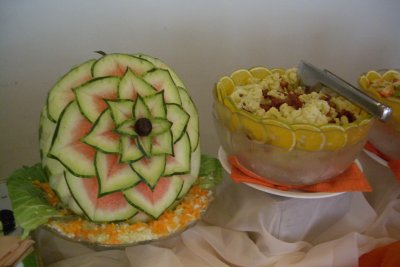 After a couple of hours, David and I came back to our hotel, stopping on the way to buy more bottled water, and had lunch here. We chose the 29-real buffet—a little much for lunch but a chance to sample many local specialties and decorated with a gorgeous carved watermelon. David went straight for the feijoada (black beans stewed with sausage) and never looked back, whereas I dabbled here and there—a little blue cheese, a little cauliflower-and-dried-tomato salad, a taste of shredded veggie salad, excellent little fried salt-cod balls, "Grenoblois" fish (fried and dressed with capers and lime), beef stewed with green peas—and I had to agree that the feijoada was the big winner. In addition to the excellent bits of ham and fat slices of sausage, it had big chunks old-fashioned grass-fed corned beef! It was my first chance to try it with the authentic accompaniments of sliced oranges and a sprinkling of toasted manioc flour. It was also excellent with a relish of minced onion, bell pepper, and tomato in a vinegary dressing.
After a couple of hours, David and I came back to our hotel, stopping on the way to buy more bottled water, and had lunch here. We chose the 29-real buffet—a little much for lunch but a chance to sample many local specialties and decorated with a gorgeous carved watermelon. David went straight for the feijoada (black beans stewed with sausage) and never looked back, whereas I dabbled here and there—a little blue cheese, a little cauliflower-and-dried-tomato salad, a taste of shredded veggie salad, excellent little fried salt-cod balls, "Grenoblois" fish (fried and dressed with capers and lime), beef stewed with green peas—and I had to agree that the feijoada was the big winner. In addition to the excellent bits of ham and fat slices of sausage, it had big chunks old-fashioned grass-fed corned beef! It was my first chance to try it with the authentic accompaniments of sliced oranges and a sprinkling of toasted manioc flour. It was also excellent with a relish of minced onion, bell pepper, and tomato in a vinegary dressing.
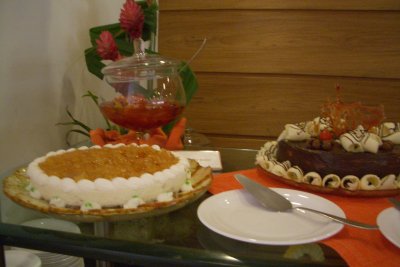 For dessert, David had the "prestige cake," a deep tart with a top layer of chocolate cream, a bottom layer of vanilla cream, and a middle layer of sliced strawberries. I tried the sliced fresh guava and mango, a piece of "banana compote" (starch green banana slices stewed in a red fruit syrup), and a slice of "puddin de laite" ("milk pudding," a rich flan with thick caramel sauce).
For dessert, David had the "prestige cake," a deep tart with a top layer of chocolate cream, a bottom layer of vanilla cream, and a middle layer of sliced strawberries. I tried the sliced fresh guava and mango, a piece of "banana compote" (starch green banana slices stewed in a red fruit syrup), and a slice of "puddin de laite" ("milk pudding," a rich flan with thick caramel sauce).
At 3 p.m., they pile us all on buses for an outing to Olinda, a beach town north of Recife.
Written 30 July 2007
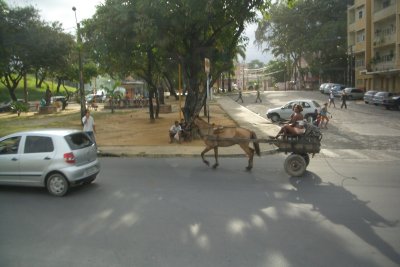 After a nap (and, for me, some work on this blog), we reassembled, with the rest of the meeting participants to board two huge, comfy, air-conditioned tourist buses (each accompanied by a pretty-good-English speaking professional tour guide) for the trip to Olinda. Our hotels are located on the "Boa Viagem" ("Bon Voyage") beach, well south of the center of Recife. The city center occupies both a section of the mainland and three islands, all linked by a veritable web of bridges. On our way to Olinda, which is north of the city, we drove across two of the islands—Santo Antonio and Recife. The latter is the oldest part of the city. We were told that the first synagogue in the Western Hemisphere was founded there before "the same group" (according to the guide) went on to New York to found the first synagogue in North America. As we approached Olinda, we saw several of these quick, skinny, little horses, some pulling carts and some being ridden. Apparently, country people bring them into town on market days.
After a nap (and, for me, some work on this blog), we reassembled, with the rest of the meeting participants to board two huge, comfy, air-conditioned tourist buses (each accompanied by a pretty-good-English speaking professional tour guide) for the trip to Olinda. Our hotels are located on the "Boa Viagem" ("Bon Voyage") beach, well south of the center of Recife. The city center occupies both a section of the mainland and three islands, all linked by a veritable web of bridges. On our way to Olinda, which is north of the city, we drove across two of the islands—Santo Antonio and Recife. The latter is the oldest part of the city. We were told that the first synagogue in the Western Hemisphere was founded there before "the same group" (according to the guide) went on to New York to found the first synagogue in North America. As we approached Olinda, we saw several of these quick, skinny, little horses, some pulling carts and some being ridden. Apparently, country people bring them into town on market days.
Olinda is older than Recife and was prosperous earlier in its history, but when the new port at Recife (called Pernambuco at the time) opened, commerce moved south, so Olinda remains largely frozen in time for the typical reason of economic depression. It is densely populated with religious institutions—several orders each of nuns and monks/friars and an amazing number of churches—some of which date from the 14th century.
Our outing was to the Convent of San Francisco, a Franciscan convent, which sits at the top of Olinda hill. The buses dropped us at the bottom, and we walked a few hundred yards up to the convent. (Among the things we learned were several distinctions in religious terminology: San Francisco is a convent, because it is occupied by friars, who interact with the outside world, and not a monastery, which would be occupied by monks, who would not.)
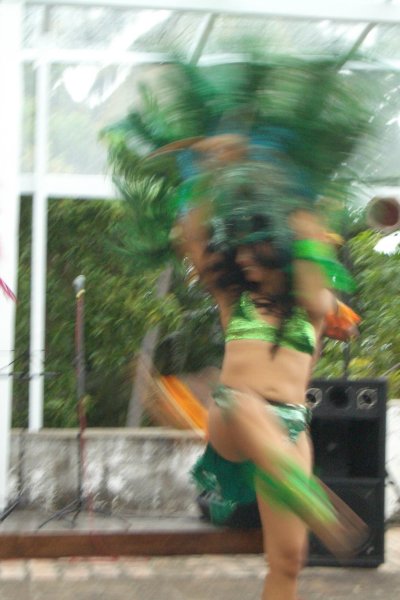 The organizers of the meeting agonized for weeks about the choice of venue for this outing. A major feature of the trip was to an exhibition of indigenous Brizilian dance, and this is the rainy season. The only indoor venue available was really too small and had a very low ceiling. The only outdoor venue with room for a live band was completely unprotected. San Francisco was the compromise—no room for the band, but for a wedding scheduled for the day before our outing, a large clear plastic canopy had been erected over the terrace, and the friars agreed to leave it in place for us. As it turned out, the committee made the right choice. We walked up the hill to the convent, strolled out onto the terrace to admire the sea view, took a few quick pictures, then retreated under the canopy as the skies opened.
The organizers of the meeting agonized for weeks about the choice of venue for this outing. A major feature of the trip was to an exhibition of indigenous Brizilian dance, and this is the rainy season. The only indoor venue available was really too small and had a very low ceiling. The only outdoor venue with room for a live band was completely unprotected. San Francisco was the compromise—no room for the band, but for a wedding scheduled for the day before our outing, a large clear plastic canopy had been erected over the terrace, and the friars agreed to leave it in place for us. As it turned out, the committee made the right choice. We walked up the hill to the convent, strolled out onto the terrace to admire the sea view, took a few quick pictures, then retreated under the canopy as the skies opened.
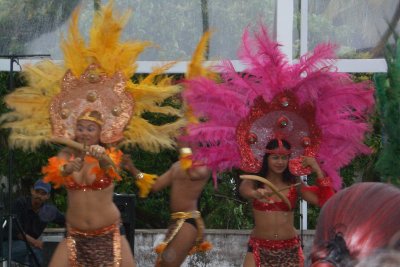 During the rain, the dance exhibition proceeded as scheduled (with recorded music), under the canopy—only one row of chairs, which happened to be lined up under a seam in the plastic, got thoroughly dripped on. Quite a number of different dance styles and costumes succeeded one another (a narrator was supposed to be available to explain the different dances, but his flight was cancelled). Apparently, all were characteristic of Brazil, but only of the northeastern region, where we are. Brazilians from Rio assured us that they were all very different from the dances they see in that part of the country.
During the rain, the dance exhibition proceeded as scheduled (with recorded music), under the canopy—only one row of chairs, which happened to be lined up under a seam in the plastic, got thoroughly dripped on. Quite a number of different dance styles and costumes succeeded one another (a narrator was supposed to be available to explain the different dances, but his flight was cancelled). Apparently, all were characteristic of Brazil, but only of the northeastern region, where we are. Brazilians from Rio assured us that they were all very different from the dances they see in that part of the country.
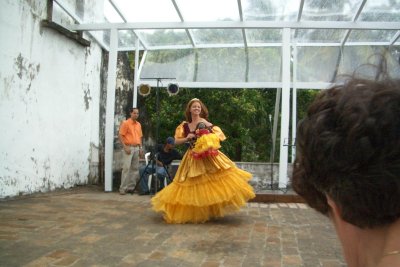
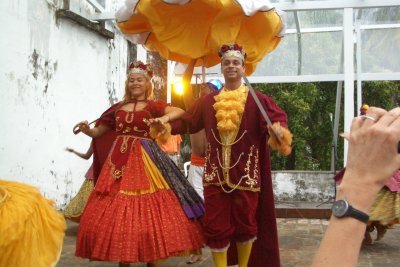
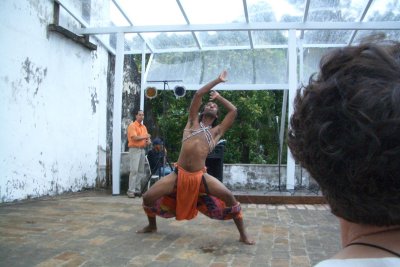
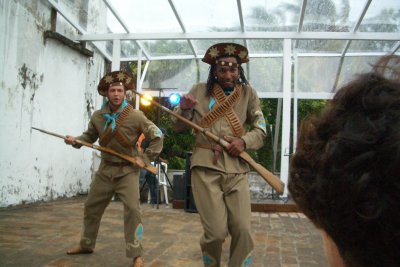 Meanwhile, a bar inside the building dispensed the local drink, the "caipirinha," to all comers. Traditionally, it consists of slices of lime crushed in a glass with sugar (with a special pestle designed for the purpose), then topped with a shot of "cachaça" (the local rum-like liquor), then filled up with ice. On this occasion, though, the bar was loaded with big glass bowls filled with chunks of fresh fruit, one each of lime slices, kiwi chunks, pineapple chunks, and fresh strawberries. Each drinker could specify which fruit should be crushed with the sugar, then what liquor should be added—cachaça, actual rum, vodka (in which case the drink is called a "caipiroska"), crême de menthe, even chocolate liqueur!
Meanwhile, a bar inside the building dispensed the local drink, the "caipirinha," to all comers. Traditionally, it consists of slices of lime crushed in a glass with sugar (with a special pestle designed for the purpose), then topped with a shot of "cachaça" (the local rum-like liquor), then filled up with ice. On this occasion, though, the bar was loaded with big glass bowls filled with chunks of fresh fruit, one each of lime slices, kiwi chunks, pineapple chunks, and fresh strawberries. Each drinker could specify which fruit should be crushed with the sugar, then what liquor should be added—cachaça, actual rum, vodka (in which case the drink is called a "caipiroska"), crême de menthe, even chocolate liqueur!
Waiters passed trays of nibbles: wine glasses containing lettuce, grated cheese, and mango chunks; small teacups full of cold black-eyed-pea salad; cold boiled shrimp on skewers with a creamy dipping sauce. (Some of us saved our skewers and used them to raid the fruit bowls on the bar!)
Originally, plans had included a guided walking tour of the old section of Olinda, but because of the rain, we confined ourselves to an excellent guided tour of the convent, conducted by Brother (Father?) Ernesto, aided by our tour guide as translator. As usual, words that the translator had difficulty with echoed around our very international group, among people who spoke different combinations of languages (and practiced different religions), until the proper English term popped up and everyone got a translation into some comprehensible language.
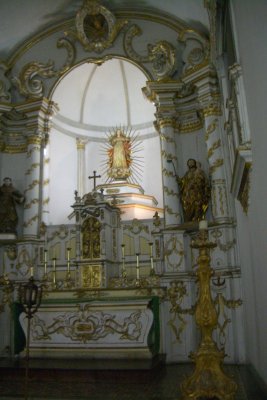 Brother Ernesto spoke wonderfully clear, slow, and distinct Portuguese, and I was astonished how much of it I could follow. He turned out actually to be German, the last of a large group of friars recruited from outside Brazil during a period when Brazilians were forbidden to join the Franciscan order. Nowadays, he's one of five friars who occupy the convent, three of whom are also priests. They conduct three public masses weekly, but attendance is very low, partly because all of Olinda doesn't have a large enough population to fill half of its churches at a time, and partly because the convent is surrounded by large estates, so very few people actually live within easy walking distance. An interesting feature of the church is that the choir, where the friars sing and chant five times daily, is located not in the apse of the church, as is usual, but in a sort of balcony in the back, where the temperature is lower and ventilation is better. All the Franciscan churches (and perhaps others) in northeastern Brazil enjoy the same dispensation permitting this arrangement, because of the extremely hot summer weather. (It's winter here now; highs are in the low 80's and lows in the low 70's.)
Brother Ernesto spoke wonderfully clear, slow, and distinct Portuguese, and I was astonished how much of it I could follow. He turned out actually to be German, the last of a large group of friars recruited from outside Brazil during a period when Brazilians were forbidden to join the Franciscan order. Nowadays, he's one of five friars who occupy the convent, three of whom are also priests. They conduct three public masses weekly, but attendance is very low, partly because all of Olinda doesn't have a large enough population to fill half of its churches at a time, and partly because the convent is surrounded by large estates, so very few people actually live within easy walking distance. An interesting feature of the church is that the choir, where the friars sing and chant five times daily, is located not in the apse of the church, as is usual, but in a sort of balcony in the back, where the temperature is lower and ventilation is better. All the Franciscan churches (and perhaps others) in northeastern Brazil enjoy the same dispensation permitting this arrangement, because of the extremely hot summer weather. (It's winter here now; highs are in the low 80's and lows in the low 70's.)
Olinda was founded in 1535, and the convent was originally built in 1585, but it was sacked and destroyed in 1631 when the Dutch invaded and took over the area from the Portuguese. When the Portuguese returned some years later, it was rebuilt, but it has suffered frequent setbacks and thefts over the centuries (note that the statue of the virgin Mary in the photo is bare-headed and empty-handed; her halo and the baby Jesus were stolen less than 10 years ago), so it boasts no golden treasury, and the oldest books in its library date from the 19th century. It does have some gorgeous rococo wood carvings three hundred years old. They're made of jacaranda wood, which apparently explains their imperviousness to woodworm and insects.
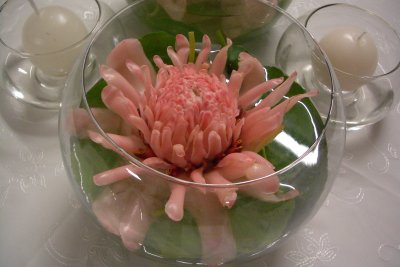 After the tour, we were treated to a lovely buffet banquet there in the convent. I had chicken salad with white sweet potato and mango chunks, green salad with strawberries, a white purée (potato or manioc beaten with mild cheese?), a creamy orange purée (orange sweet potato?), seafood (shrimp, squid, and oysters) stewed in coconut milk, rice with nuts (cashews?), a fresh salsa, granulated manioc tossed with chunks of something sweetish (candied white sweet potato?), and a piece of the ubiquitous grilled beef tenderloin. For dessert, I had a slice of mild cheese drizzled with a dark syrup (that tasted like molasses but was described as "miele," which ought to mean honey), a shriveled starchy fruit preserved in syrup, and a sort of jelly roll consisting of an unbelievably thin sponge cake rolled into many, many layers with guava jelly. Each table featured a centerpiece of a couple of these lovely pink flowers (for scale, the spherical candles are the size of hens' eggs; the leaves under them were some other species), which we never succeeded in identifying. Proteas (not really the right texture)? Foreshortened gingers of some sort? Cactus even? Anybody have any ideas?
After the tour, we were treated to a lovely buffet banquet there in the convent. I had chicken salad with white sweet potato and mango chunks, green salad with strawberries, a white purée (potato or manioc beaten with mild cheese?), a creamy orange purée (orange sweet potato?), seafood (shrimp, squid, and oysters) stewed in coconut milk, rice with nuts (cashews?), a fresh salsa, granulated manioc tossed with chunks of something sweetish (candied white sweet potato?), and a piece of the ubiquitous grilled beef tenderloin. For dessert, I had a slice of mild cheese drizzled with a dark syrup (that tasted like molasses but was described as "miele," which ought to mean honey), a shriveled starchy fruit preserved in syrup, and a sort of jelly roll consisting of an unbelievably thin sponge cake rolled into many, many layers with guava jelly. Each table featured a centerpiece of a couple of these lovely pink flowers (for scale, the spherical candles are the size of hens' eggs; the leaves under them were some other species), which we never succeeded in identifying. Proteas (not really the right texture)? Foreshortened gingers of some sort? Cactus even? Anybody have any ideas?
Throughout the proceedings, we were watched (watched over, I like to think) by the "tourist police"—so labeled, in Portuguese and English, on their uniforms and cars. A colleague leaned over at one point to whisper, "Are those flack jackets they're wearing?!" "No, no," I replied, "I'm sure they're just vests with pouches for the aspirin, alkaselzer, imodium, sunburn cream, bandaids for blisters, and so on." When the party wound down, they gathered us all into a group to walk down the hill together to where the buses were parked (we've been told never to walk anywhere alone, especially after dark). The guides led the way, and behind the last of us, creeping along like the sweep-up car in a bike race, came the tourist police in their squad car.
previous entry
List of Entries
next entry
 The rain has returned, but I can see a big patch of sun out over the sea, and it seems to be coming this way. The tide has receded sufficiently to reveal a line of flat black rocks, a few yards below the beach—part of the reef for which Recife is named.
The rain has returned, but I can see a big patch of sun out over the sea, and it seems to be coming this way. The tide has receded sufficiently to reveal a line of flat black rocks, a few yards below the beach—part of the reef for which Recife is named. The hotel's buffet breakfast is included in the price of our room, and quite a nice one it is: several kinds of cut and whole fruit, three cheeses, ham, salami, mortadella, half a dozen kinds of little sweet and savory yeast breads, butter, jam, cereals, coffee, tea, hot chocolate, cakes, pastries, flans, and chafing dishes full of little spherical cheese breads (delicious!), hot sliced sausages sautéed with onions, scrambled eggs (of no great merit), crisp bacon, chunks of hot boiled yam, domes of polenta as big around as fried eggs in a sauce of what seems to be warm milk, and finely shredded "jerked beef" sautéed with onions and chilis.
The hotel's buffet breakfast is included in the price of our room, and quite a nice one it is: several kinds of cut and whole fruit, three cheeses, ham, salami, mortadella, half a dozen kinds of little sweet and savory yeast breads, butter, jam, cereals, coffee, tea, hot chocolate, cakes, pastries, flans, and chafing dishes full of little spherical cheese breads (delicious!), hot sliced sausages sautéed with onions, scrambled eggs (of no great merit), crisp bacon, chunks of hot boiled yam, domes of polenta as big around as fried eggs in a sauce of what seems to be warm milk, and finely shredded "jerked beef" sautéed with onions and chilis. After a couple of hours, David and I came back to our hotel, stopping on the way to buy more bottled water, and had lunch here. We chose the 29-real buffet—a little much for lunch but a chance to sample many local specialties and decorated with a gorgeous carved watermelon. David went straight for the feijoada (black beans stewed with sausage) and never looked back, whereas I dabbled here and there—a little blue cheese, a little cauliflower-and-dried-tomato salad, a taste of shredded veggie salad, excellent little fried salt-cod balls, "Grenoblois" fish (fried and dressed with capers and lime), beef stewed with green peas—and I had to agree that the feijoada was the big winner. In addition to the excellent bits of ham and fat slices of sausage, it had big chunks old-fashioned grass-fed corned beef! It was my first chance to try it with the authentic accompaniments of sliced oranges and a sprinkling of toasted manioc flour. It was also excellent with a relish of minced onion, bell pepper, and tomato in a vinegary dressing.
After a couple of hours, David and I came back to our hotel, stopping on the way to buy more bottled water, and had lunch here. We chose the 29-real buffet—a little much for lunch but a chance to sample many local specialties and decorated with a gorgeous carved watermelon. David went straight for the feijoada (black beans stewed with sausage) and never looked back, whereas I dabbled here and there—a little blue cheese, a little cauliflower-and-dried-tomato salad, a taste of shredded veggie salad, excellent little fried salt-cod balls, "Grenoblois" fish (fried and dressed with capers and lime), beef stewed with green peas—and I had to agree that the feijoada was the big winner. In addition to the excellent bits of ham and fat slices of sausage, it had big chunks old-fashioned grass-fed corned beef! It was my first chance to try it with the authentic accompaniments of sliced oranges and a sprinkling of toasted manioc flour. It was also excellent with a relish of minced onion, bell pepper, and tomato in a vinegary dressing. For dessert, David had the "prestige cake," a deep tart with a top layer of chocolate cream, a bottom layer of vanilla cream, and a middle layer of sliced strawberries. I tried the sliced fresh guava and mango, a piece of "banana compote" (starch green banana slices stewed in a red fruit syrup), and a slice of "puddin de laite" ("milk pudding," a rich flan with thick caramel sauce).
For dessert, David had the "prestige cake," a deep tart with a top layer of chocolate cream, a bottom layer of vanilla cream, and a middle layer of sliced strawberries. I tried the sliced fresh guava and mango, a piece of "banana compote" (starch green banana slices stewed in a red fruit syrup), and a slice of "puddin de laite" ("milk pudding," a rich flan with thick caramel sauce). After a nap (and, for me, some work on this blog), we reassembled, with the rest of the meeting participants to board two huge, comfy, air-conditioned tourist buses (each accompanied by a pretty-good-English speaking professional tour guide) for the trip to Olinda. Our hotels are located on the "Boa Viagem" ("Bon Voyage") beach, well south of the center of Recife. The city center occupies both a section of the mainland and three islands, all linked by a veritable web of bridges. On our way to Olinda, which is north of the city, we drove across two of the islands—Santo Antonio and Recife. The latter is the oldest part of the city. We were told that the first synagogue in the Western Hemisphere was founded there before "the same group" (according to the guide) went on to New York to found the first synagogue in North America. As we approached Olinda, we saw several of these quick, skinny, little horses, some pulling carts and some being ridden. Apparently, country people bring them into town on market days.
After a nap (and, for me, some work on this blog), we reassembled, with the rest of the meeting participants to board two huge, comfy, air-conditioned tourist buses (each accompanied by a pretty-good-English speaking professional tour guide) for the trip to Olinda. Our hotels are located on the "Boa Viagem" ("Bon Voyage") beach, well south of the center of Recife. The city center occupies both a section of the mainland and three islands, all linked by a veritable web of bridges. On our way to Olinda, which is north of the city, we drove across two of the islands—Santo Antonio and Recife. The latter is the oldest part of the city. We were told that the first synagogue in the Western Hemisphere was founded there before "the same group" (according to the guide) went on to New York to found the first synagogue in North America. As we approached Olinda, we saw several of these quick, skinny, little horses, some pulling carts and some being ridden. Apparently, country people bring them into town on market days. The organizers of the meeting agonized for weeks about the choice of venue for this outing. A major feature of the trip was to an exhibition of indigenous Brizilian dance, and this is the rainy season. The only indoor venue available was really too small and had a very low ceiling. The only outdoor venue with room for a live band was completely unprotected. San Francisco was the compromise—no room for the band, but for a wedding scheduled for the day before our outing, a large clear plastic canopy had been erected over the terrace, and the friars agreed to leave it in place for us. As it turned out, the committee made the right choice. We walked up the hill to the convent, strolled out onto the terrace to admire the sea view, took a few quick pictures, then retreated under the canopy as the skies opened.
The organizers of the meeting agonized for weeks about the choice of venue for this outing. A major feature of the trip was to an exhibition of indigenous Brizilian dance, and this is the rainy season. The only indoor venue available was really too small and had a very low ceiling. The only outdoor venue with room for a live band was completely unprotected. San Francisco was the compromise—no room for the band, but for a wedding scheduled for the day before our outing, a large clear plastic canopy had been erected over the terrace, and the friars agreed to leave it in place for us. As it turned out, the committee made the right choice. We walked up the hill to the convent, strolled out onto the terrace to admire the sea view, took a few quick pictures, then retreated under the canopy as the skies opened. During the rain, the dance exhibition proceeded as scheduled (with recorded music), under the canopy—only one row of chairs, which happened to be lined up under a seam in the plastic, got thoroughly dripped on. Quite a number of different dance styles and costumes succeeded one another (a narrator was supposed to be available to explain the different dances, but his flight was cancelled). Apparently, all were characteristic of Brazil, but only of the northeastern region, where we are. Brazilians from Rio assured us that they were all very different from the dances they see in that part of the country.
During the rain, the dance exhibition proceeded as scheduled (with recorded music), under the canopy—only one row of chairs, which happened to be lined up under a seam in the plastic, got thoroughly dripped on. Quite a number of different dance styles and costumes succeeded one another (a narrator was supposed to be available to explain the different dances, but his flight was cancelled). Apparently, all were characteristic of Brazil, but only of the northeastern region, where we are. Brazilians from Rio assured us that they were all very different from the dances they see in that part of the country. 


 Meanwhile, a bar inside the building dispensed the local drink, the "caipirinha," to all comers. Traditionally, it consists of slices of lime crushed in a glass with sugar (with a special pestle designed for the purpose), then topped with a shot of "cachaça" (the local rum-like liquor), then filled up with ice. On this occasion, though, the bar was loaded with big glass bowls filled with chunks of fresh fruit, one each of lime slices, kiwi chunks, pineapple chunks, and fresh strawberries. Each drinker could specify which fruit should be crushed with the sugar, then what liquor should be added—cachaça, actual rum, vodka (in which case the drink is called a "caipiroska"), crême de menthe, even chocolate liqueur!
Meanwhile, a bar inside the building dispensed the local drink, the "caipirinha," to all comers. Traditionally, it consists of slices of lime crushed in a glass with sugar (with a special pestle designed for the purpose), then topped with a shot of "cachaça" (the local rum-like liquor), then filled up with ice. On this occasion, though, the bar was loaded with big glass bowls filled with chunks of fresh fruit, one each of lime slices, kiwi chunks, pineapple chunks, and fresh strawberries. Each drinker could specify which fruit should be crushed with the sugar, then what liquor should be added—cachaça, actual rum, vodka (in which case the drink is called a "caipiroska"), crême de menthe, even chocolate liqueur!  Brother Ernesto spoke wonderfully clear, slow, and distinct Portuguese, and I was astonished how much of it I could follow. He turned out actually to be German, the last of a large group of friars recruited from outside Brazil during a period when Brazilians were forbidden to join the Franciscan order. Nowadays, he's one of five friars who occupy the convent, three of whom are also priests. They conduct three public masses weekly, but attendance is very low, partly because all of Olinda doesn't have a large enough population to fill half of its churches at a time, and partly because the convent is surrounded by large estates, so very few people actually live within easy walking distance. An interesting feature of the church is that the choir, where the friars sing and chant five times daily, is located not in the apse of the church, as is usual, but in a sort of balcony in the back, where the temperature is lower and ventilation is better. All the Franciscan churches (and perhaps others) in northeastern Brazil enjoy the same dispensation permitting this arrangement, because of the extremely hot summer weather. (It's winter here now; highs are in the low 80's and lows in the low 70's.)
Brother Ernesto spoke wonderfully clear, slow, and distinct Portuguese, and I was astonished how much of it I could follow. He turned out actually to be German, the last of a large group of friars recruited from outside Brazil during a period when Brazilians were forbidden to join the Franciscan order. Nowadays, he's one of five friars who occupy the convent, three of whom are also priests. They conduct three public masses weekly, but attendance is very low, partly because all of Olinda doesn't have a large enough population to fill half of its churches at a time, and partly because the convent is surrounded by large estates, so very few people actually live within easy walking distance. An interesting feature of the church is that the choir, where the friars sing and chant five times daily, is located not in the apse of the church, as is usual, but in a sort of balcony in the back, where the temperature is lower and ventilation is better. All the Franciscan churches (and perhaps others) in northeastern Brazil enjoy the same dispensation permitting this arrangement, because of the extremely hot summer weather. (It's winter here now; highs are in the low 80's and lows in the low 70's.) After the tour, we were treated to a lovely buffet banquet there in the convent. I had chicken salad with white sweet potato and mango chunks, green salad with strawberries, a white purée (potato or manioc beaten with mild cheese?), a creamy orange purée (orange sweet potato?), seafood (shrimp, squid, and oysters) stewed in coconut milk, rice with nuts (cashews?), a fresh salsa, granulated manioc tossed with chunks of something sweetish (candied white sweet potato?), and a piece of the ubiquitous grilled beef tenderloin. For dessert, I had a slice of mild cheese drizzled with a dark syrup (that tasted like molasses but was described as "miele," which ought to mean honey), a shriveled starchy fruit preserved in syrup, and a sort of jelly roll consisting of an unbelievably thin sponge cake rolled into many, many layers with guava jelly. Each table featured a centerpiece of a couple of these lovely pink flowers (for scale, the spherical candles are the size of hens' eggs; the leaves under them were some other species), which we never succeeded in identifying. Proteas (not really the right texture)? Foreshortened gingers of some sort? Cactus even? Anybody have any ideas?
After the tour, we were treated to a lovely buffet banquet there in the convent. I had chicken salad with white sweet potato and mango chunks, green salad with strawberries, a white purée (potato or manioc beaten with mild cheese?), a creamy orange purée (orange sweet potato?), seafood (shrimp, squid, and oysters) stewed in coconut milk, rice with nuts (cashews?), a fresh salsa, granulated manioc tossed with chunks of something sweetish (candied white sweet potato?), and a piece of the ubiquitous grilled beef tenderloin. For dessert, I had a slice of mild cheese drizzled with a dark syrup (that tasted like molasses but was described as "miele," which ought to mean honey), a shriveled starchy fruit preserved in syrup, and a sort of jelly roll consisting of an unbelievably thin sponge cake rolled into many, many layers with guava jelly. Each table featured a centerpiece of a couple of these lovely pink flowers (for scale, the spherical candles are the size of hens' eggs; the leaves under them were some other species), which we never succeeded in identifying. Proteas (not really the right texture)? Foreshortened gingers of some sort? Cactus even? Anybody have any ideas?